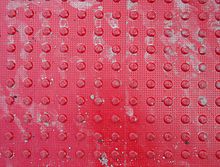Parts of a Workl of Art Texture Colors Subject
In the visual arts, texture is the perceived surface quality of a work of art. It is an chemical element of two-dimensional and three-dimensional designs and is distinguished by its perceived visual and physical properties. Use of texture, along with other elements of design, can convey a multifariousness of messages and emotions.
Physical texture [edit]

The physical texture (also known as actual texture or tactile texture) are the patterns of variations upon a solid surface. These can include -- but are non limited to -- fur, canvas, forest grain, sand, leather, satin, eggshell, matte, or polish surfaces such equally metal or glass.
Physical texture differentiates itself from visual texture by having a physical quality that tin exist felt by touching the surface of the texture. Specific use of a texture can bear upon the smoothness that an artwork conveys. For example, use of rough surfaces can be visually active, whilst smooth surfaces can exist visually restful. The use of both can requite a sense of personality to a design, or utilized to create accent, rhythm, contrast, etc.[1]
Low-cal is an important gene for identifying the concrete texture because information technology can affect how a surface is existence viewed. Stiff lights on a smoothen surface tin obscure the readability of a drawing or photograph, whilst they can create strong contrasts in a highly textural surface such every bit river rocks, sand, etc.
Visual texture [edit]
Visual texture or implied texture is the illusion of having physical texture. Every material and every support surface has its own visual texture and needs to be taken into consideration earlier creating a composition. Equally such, materials such as canvas and watercolour paper are considerably rougher than, for example, photograph-quality calculator newspaper and may not be best suited to creating a flat, smooth texture. Photography, drawings and paintings use visual texture both to portray their own subject affair realistically and with interpretation. Texture in these media is more often than not created past the repetition of the shape and line. Some other example of visual texture is terrazzo or an prototype in a mirror.
Decorative texture [edit]
Decorative texture "decorates a surface". Texture is added to embellish the surface either that commonly contains some uniformity.
Spontaneous texture [edit]
This focuses more on the process of the visual creation; the marks of texture fabricated also creates the shapes. These are ofttimes "adventitious" forms that create texture.
Mechanical texture [edit]
Texture created by special mechanical ways. An example of this would exist photography; the grains and/or screen pattern that is oft found in printing creates texture on the surface. This is also exemplified past designs in typography and computer graphics.
Hypertexture [edit]
Hypertexture can be defined every bit both the "realistic faux surface texture produced past adding small distortions across the surface of an object"[2] (as pioneered by Ken Perlin) and as an avenue for describing the fluid morphic nature of texture in the realm of cyber graphics and the tranversally responsive works created in the field of visual arts therein (as described past Lee Klein).[3]
Examples of physical texture [edit]
-
Particular of woven fibers of a carpet
-

Animals are often defined past their concrete texture, such as a fuzzy kitten or this scaly iguana.
-

Blades of grass provides a soft texture
-

Rough bawl on the surface of a tree
-

A wall of bricks with raised areas
-

Auto Texture created over Clear glass Bricks
Examples of visual texture [edit]
-

-

An image that has been digitally altered to evidence text and newspaper texture over a photograph
Some copyright-gratis texture resources [edit]
- AmbientCG - 2000+ CCO Textures
- ShareTextures - g+ copyright-free Textures [iv]
- PolyHaven - 200+ CC0 Textures
See also [edit]
- Limerick (visual arts)
- Visual design elements and principles
- Elements of art
- Texture (painting)
- Texture mapping
- Art movement
- Creativity techniques
- Listing of fine art media
- List of artistic media
- List of art movements
- List of fine art techniques
References [edit]
Citations [edit]
- ^ Gatto. Exploring Visual Blueprint: The Elements and Principles. pp. 122–123.
- ^ "What does HYPERTEXTURE hateful?". Definitions.net. Retrieved 2013-08-17 .
- ^ "Hypertexture | A Gathering of the Tribes". Tribes.org. 2006-x-01. Retrieved 2013-08-17 .
- ^ CC0 Texture Resources
Sources [edit]
- Gatto, Porter, and Selleck. Exploring Visual Design: The Elements and Principles. 3rd ed. Worcester: Davis Publications, Inc., 2000. ISBN 0-87192-379-3
- Stewart, Mary, Launching the imagination: a comprehensive guide to basic design. 2nd ed. New York: The McGraw-Hill Companies, Inc., 2006. ISBN 0-07-287061-3
Source: https://en.wikipedia.org/wiki/Texture_(visual_arts)

Belum ada Komentar untuk "Parts of a Workl of Art Texture Colors Subject"
Posting Komentar